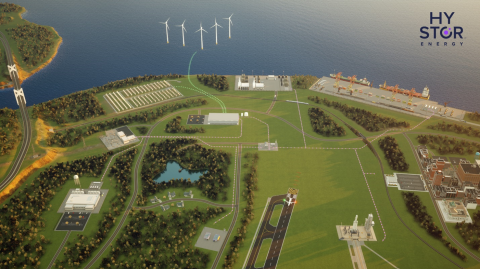When you’re in competition for billions in federal dollars, you need more than just a sensible approach and a strong economic case. You need a real competitive advantage. That’s what Hy Stor Energy believes it has with its proposed Mississippi Clean Hydrogen Hub (MCHH). It sees off-the-grid renewable power and extensive salt-dome storage capabilities as the surest path to decarbonization for a myriad of industrial needs. In today’s RBN blog, we look at the overall strategy behind the MCHH, the plan to produce 100% green hydrogen, and how Hy Stor hopes to beat the competition and secure Department of Energy (DOE) funding for a regional hydrogen hub.
The U.S. has made clean hydrogen a priority, with the federal government’s Regional Clean Hydrogen Hubs (H2Hubs) initiative intended to accelerate the process, but we should note that there are a number of strong proposals out there and only a handful of hubs are likely to receive funding. The DOE opened up $7 billion in funding in September 2022 for the development of as many as six to 10 regional hubs. For the first stage of the hub-selection process, the DOE’s Office of Clean Energy Demonstration (OCED), which will administer the hydrogen-hub funding, required interested parties to submit concept papers about their planned projects. Of the 79 papers that were submitted, 33 were encouraged at the end of 2022 to submit a full application by the April 7 deadline. We were able to identify most of the encouraged projects and examined the major factors that are likely to influence a project’s viability in the eyes of the DOE. We obtained the full list of the encouraged projects a few weeks ago, which helped us understand the wide range of proposals the DOE is considering. (We’re also pursuing the list of projects that submitted a full application to the DOE. When we get it, that’ll be the topic of a future blog. For the latest hydrogen news, including a map of all 33 encouraged projects and the lead organization for each, check our weekly Hydrogen Billboard.)
Details about many of the projects seeking hub funding have been scarce. The application process has been kept mostly out of public view — concept papers didn’t have to be publicly disclosed and, as noted above, it’s been difficult to learn much about the projects under consideration. One exception that we detailed in a recent blog is the Leading in Gulf Coast Hydrogen Transition (LIGH2T) hub, which focuses on three key elements likely to curry favor with the DOE: development of a national hydrogen network, the need to grow hydrogen demand, and strong community connections. We should point out that one of the strengths of LIGH2T’s hub concept is its consortium of backers, which includes a large group of states, some key commercial partners, several universities and the National Energy Technology Laboratory. That’s a similarity it shares with the MCHH, which touts partnerships with a variety of federal agencies, national labs, universities, community colleges and industry stakeholders. The hub would be built and operated in collaboration with the Pacific Northwest National Laboratory, National Renewable Laboratory, Sandia National Laboratory and Oakridge National Laboratory. Its university partners include Jackson State University, the University of Southern Mississippi and Alcorn State University, in addition to several community colleges. Its equity partner is Toronto-based CC&L Infrastructure, which has invested in a number of energy projects across the Americas, including solar, hydroelectric and wind power.
Figure 1. Rendering of Mississippi Clean Hydrogen Hub and Related Infrastructure.
Source: Hy Stor Energy
Join Backstage Pass to Read Full Article










